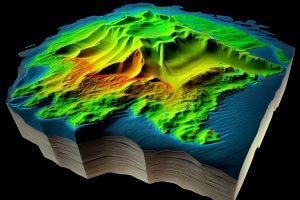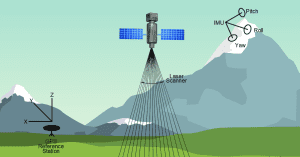Optics for LIDAR and sensing have become much more affordable over the past decade, with this useful technology currently accessible to almost anyone. The newer iPhone Pro can even function as a handheld LiDAR system, though this is currently less of a practical tool and more of a novelty application.
Light Detection and Ranging (LiDAR) was introduced in 1961, shortly after the invention of the laser. LiDAR was initially developed to track satellites by measuring the time taken for a laser signal to return to the source device.
In 1971, a LiDAR altimeter was employed in mapping the surface of the moon, but this device was huge, costly, and did not provide accurate results.
This key photonic technology is now utilized in thousands of applications, with improved LiDAR technology seeing uses in map creation, the investigation of archaeological sites, and as a means of detecting the surroundings of autonomous vehicles.
This article explores the fundamental principles of LiDAR and outlines the requirements of a successful, high-performance LiDAR system.
What is LiDAR?
A LiDAR system is a photonic analogy of radar. Where radar uses soundwaves to detect objects, LiDAR uses light from a precisely directed, rapidly firing laser being bounced off terrain or a specific object.
As the light returns, time of flight calculations are performed to determine the exact distance between two points. This information can then be used to generate detailed topographical maps or three-dimensional models.

LiDAR mapping is derived from time of flight calculations on laser light. Image Credit: Avantier Inc.
Laser for LiDAR
A LiDAR system may employ UV, vis, or NIR lasers, depending on its specific design. The choice of laser will depend on the objects under surveillance and the environment that the imaging is undertaken in.
Non-scientific applications will generally utilize 600-1000 nm lasers, but these wavelengths can be damaging to the human eye, so extra care must be taken under these circumstances.
Er-doped fiber 1550 nm lasers are the most commonly used option for a range of military applications, because these are fairly harmless to the human eye and cannot be seen by night vision goggles.
These lasers are also a popular choice in topography mapping, distance measuring, and obstacle avoidance, but their reliance on InGaAs sensors makes them less affordable than lower-wavelength lasers used in other LiDAR applications.

LiDAR can use eye safe Er -doped fiber 1550 nm lasers to generate topographic maps like these. Image Credit: Avantier Inc.
Underwater and bathymetry applications necessitate the use of a laser that exhibits sufficient transmission in pure water and limited backscattering from the small particles found in seawater.
For these applications, 534 nm frequency-doubled diode-pumped YA lasers are a good choice. These lasers are able to penetrate water with minimal attenuation.
Airborne topographic mapping applications benefit from the use of 1064 nm diode-pumped YAG lasers.
A number of other laser parameters are particularly relevant to LiDAR setups, including laser power consumption, pulse repetition rate, and beam divergence.
Users will also need to choose between flash LiDAR - whereby the whole field of view is illuminated at once - or more traditional scanning LiDAR, which surveys the field of view on a point-by-point basis.
Controlling the Spectral Width with Bandpass Filters
A laser at 1064 nm is typically used for long-range airborne LiDAR systems, but this presents a particular challenge due to the high levels of background noise generated by the sun’s radiance. Signal to noise ratio can be improved in this setting by fitting a narrow bandpass filter to the LiDAR receiver.
A robust filter that is able to perform consistently and reliably is necessary when working in harsh environmental conditions. Multilayer thin film coatings that are able to accommodate transmission and narrowly match the laser wavelength are typically utilized.
In applications where narrow linewidth meter-oscillator power-amplifier (MOPA) based pulsed lasers are employed, the central wavelength is determined by the seeding laser pulse. This wavelength can also be affected by a range of diode conditions, such as drive current, temperature stabilization, and pulse repetition rate.
Wavelength control is no longer straightforward in this situation, so a bandpass filter should be selected with a band wide enough to accommodate any anticipated wavelength shifts.
Custom LiDAR Systems
Avantier focuses on custom optics solutions that are tailor-made to meet customers’ exact specifications. There is no one-size-fits-all option in the LiDAR field, with ready-made solutions rarely proving suitable for a given application.
In most cases, it is advisable to work with experienced optical engineers and designers to develop a custom-made system to meet precise specifications.
Acknowledgments
Produced from materials originally authored by Avantier Inc.

This information has been sourced, reviewed and adapted from materials provided by Avantier Inc.
For more information on this source, please visit Avantier Inc.